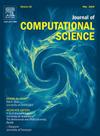A Galerkin algorithm leveraging Bernoulli polynomials for accurate solutions of time-fractional diffusion-wave equations
IF 3.7
3区 计算机科学
Q2 COMPUTER SCIENCE, INTERDISCIPLINARY APPLICATIONS
引用次数: 0
Abstract
This study presents a modified Galerkin technique utilizing Bernoulli polynomials for time-fractional diffusion-wave equations (TFDWEs). The proposed approach combines fractional calculus, namely Caputo derivatives, with a semi-discrete approach to achieve a high numerical accuracy. By utilizing Bernoulli polynomials as an efficient basis to approximate the solution, the algorithm transforms the governing equations into very sparse linear systems that can be solved computationally efficiently. Detailed numerical investigations, including applications to fractional wave equations and fourth-order diffusion-wave equations, demonstrate the method’s ability to achieve reduced errors and better computational efficiency. The results underline the stability and accuracy of the proposed technique, which turns out to be particularly suitable for simulating complex physical systems characterized by memory effects and anomalous diffusion.
利用伯努利多项式求解时间分数阶扩散波方程的伽辽金算法
本文提出了一种利用伯努利多项式求解时间分数扩散波方程的改进伽辽金技术。该方法将分数阶微积分即卡普托导数与半离散方法相结合,以达到较高的数值精度。该算法利用伯努利多项式作为近似解的有效基,将控制方程转化为可计算高效求解的非常稀疏的线性系统。详细的数值研究,包括分数阶波动方程和四阶扩散波方程的应用,证明了该方法能够实现更小的误差和更好的计算效率。结果强调了所提出的技术的稳定性和准确性,该技术特别适合于模拟具有记忆效应和异常扩散特征的复杂物理系统。
本文章由计算机程序翻译,如有差异,请以英文原文为准。
求助全文
约1分钟内获得全文
求助全文
来源期刊

Journal of Computational Science
COMPUTER SCIENCE, INTERDISCIPLINARY APPLICATIONS-COMPUTER SCIENCE, THEORY & METHODS
CiteScore
5.50
自引率
3.00%
发文量
227
审稿时长
41 days
期刊介绍:
Computational Science is a rapidly growing multi- and interdisciplinary field that uses advanced computing and data analysis to understand and solve complex problems. It has reached a level of predictive capability that now firmly complements the traditional pillars of experimentation and theory.
The recent advances in experimental techniques such as detectors, on-line sensor networks and high-resolution imaging techniques, have opened up new windows into physical and biological processes at many levels of detail. The resulting data explosion allows for detailed data driven modeling and simulation.
This new discipline in science combines computational thinking, modern computational methods, devices and collateral technologies to address problems far beyond the scope of traditional numerical methods.
Computational science typically unifies three distinct elements:
• Modeling, Algorithms and Simulations (e.g. numerical and non-numerical, discrete and continuous);
• Software developed to solve science (e.g., biological, physical, and social), engineering, medicine, and humanities problems;
• Computer and information science that develops and optimizes the advanced system hardware, software, networking, and data management components (e.g. problem solving environments).
 求助内容:
求助内容: 应助结果提醒方式:
应助结果提醒方式:


